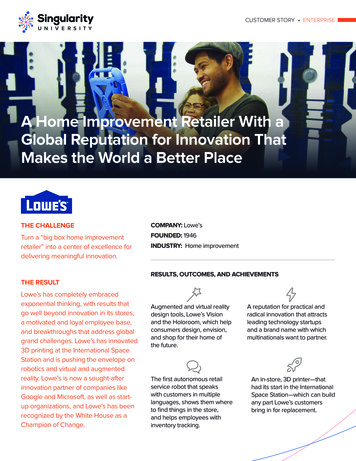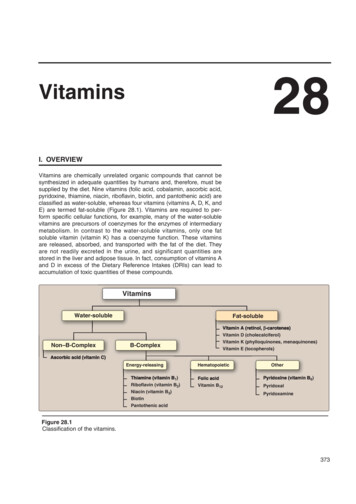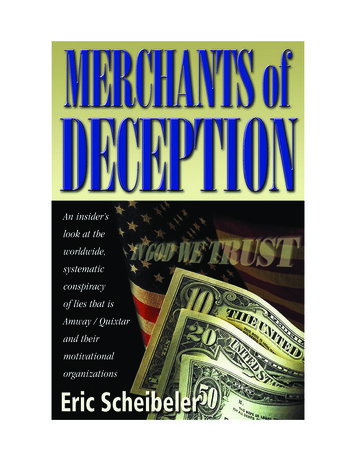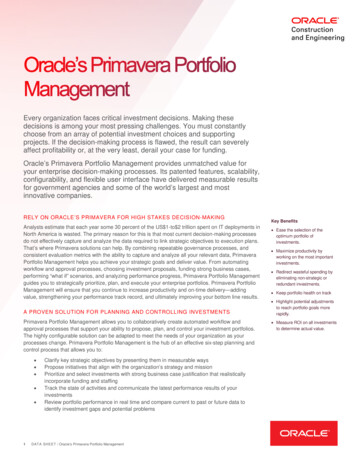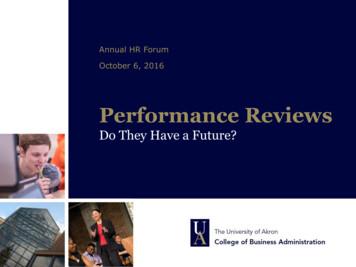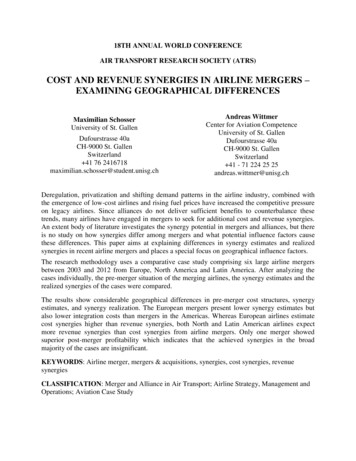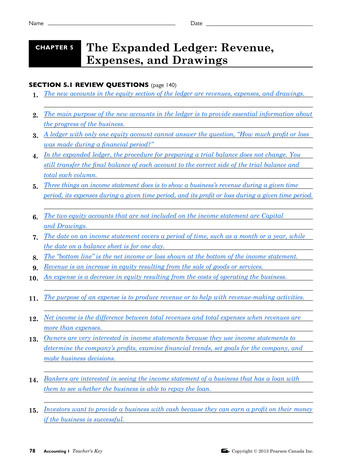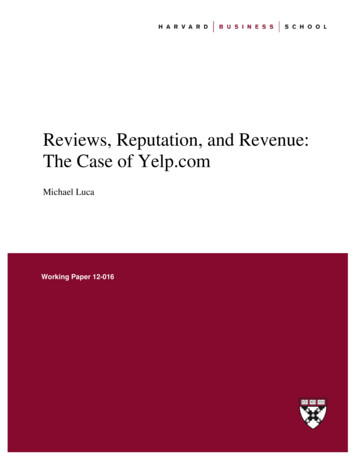
Transcription
Reviews, Reputation, and Revenue:The Case of Yelp.comMichael LucaWorking Paper 12-016
Reviews, Reputation, and Revenue: TheCase of Yelp.comMichael LucaHarvard Business SchoolWorking Paper 12-016Copyright 2011, 2016 by Michael LucaWorking papers are in draft form. This working paper is distributed for purposes of comment and discussion only. It maynot be reproduced without permission of the copyright holder. Copies of working papers are available from the author.
Reviews, Reputation, and Revenue: The Case of Yelp.comMichael Luca†AbstractDo online consumer reviews affect restaurant demand? I investigate this question using a noveldataset combining reviews from the website Yelp.com and restaurant data from the WashingtonState Department of Revenue. Because Yelp prominently displays a restaurant's roundedaverage rating, I can identify the causal impact of Yelp ratings on demand with a regressiondiscontinuity framework that exploits Yelp’s rounding thresholds. I present three findings aboutthe impact of consumer reviews on the restaurant industry: (1) a one-star increase in Yelp ratingleads to a 5-9 percent increase in revenue, (2) this effect is driven by independent restaurants;ratings do not affect restaurants with chain affiliation, and (3) chain restaurants have declined inmarket share as Yelp penetration has increased. This suggests that online consumer reviewssubstitute for more traditional forms of reputation. I then test whether consumers use thesereviews in a way that is consistent with standard learning models. I present two additionalfindings: (4) consumers do not use all available information and are more responsive to qualitychanges that are more visible and (5) consumers respond more strongly when a rating containsmore information. Consumer response to a restaurant’s average rating is affected by the numberof reviews and whether the reviewers are certified as “elite” by Yelp, but is unaffected by thesize of the reviewers’ Yelp friends network.†Harvard Business School, mluca@hbs.edu
1 IntroductionTechnological advances over the past decade have led to the proliferation of consumerreview websites such as Yelp.com, where consumers can share experiences about productquality. These reviews provide consumers with information about experience goods, which havequality that is observed only after consumption. With the click of a button, one can now acquireinformation from countless other consumers about products ranging from restaurants to moviesto physicians. This paper provides empirical evidence on the impact of consumer reviews in therestaurant industry.It is a priori unclear whether consumer reviews will significantly affect markets forexperience goods. On the one hand, existing mechanisms aimed at solving information problemsare imperfect: chain affiliation reduces product differentiation, advertising can be costly, andexpert reviews tend to cover small segments of a market.1 Consumer reviews may thereforecomplement or substitute for existing information sources. On the other hand, reviews can benoisy and difficult to interpret because they are based on subjective information reflecting theviews of a non-representative sample of consumers. Further, consumers must actively seek outreviews, in contrast to mandatory disclosure and electronic commerce settings. 2How do online consumer reviews affect markets for experience goods? Using a novel dataset consisting of reviews from the website Yelp.com and revenue data from the WashingtonState Department of Revenue, I present three key findings: (1) a one-star increase in Yelp ratingleads to a 5-9 percent increase in revenue, (2) this effect is driven by independent restaurants;ratings do not affect restaurants with chain affiliation, and (3) chain restaurants have declined in1For example, Zagat covers only about 5% of restaurants in Los Angeles, according to Jin and Leslie (2009).For an example of consumer reviews in electronic commerce, see Cabral and Hortacsu (2010). For an example ofthe impact of mandatory disclosure laws, see Mathios (2000), Jin and Leslie (2003), and Bollinger et al. (2010).22
revenue share as Yelp penetration has increased. Consistent with standard learning models,consumer response is larger when ratings contain more information. However, consumers alsoreact more strongly to information that is more visible, suggesting that the way information ispresented matters.To construct the data set for this analysis, I worked with the Washington State Department ofRevenue to gather revenues for all restaurants in Seattle from 2003 through 2009. This allowsme to observe an entire market both before and after the introduction of Yelp. I focus on Yelpbecause it has become the dominant source of consumer reviews in the restaurant industry. ForSeattle alone, the website had over 60,000 restaurant reviews covering 70% of all operationalrestaurants as of 2009.By comparison, the Seattle Times has reviewed roughly 5% ofoperational Seattle restaurants.To investigate the impact of Yelp, I first show that changes in a restaurant’s rating arecorrelated with changes in revenue, controlling for restaurant and quarter fixed effects.However, there can be concerns about interpreting this as causal if changes in a restaurant’srating are correlated with other changes in a restaurant’s reputation that would have occurredeven in the absence of Yelp. This is a well-known challenge to identifying the causal impact ofany type of reputation on demand, as described in Eliashberg and Shugan (1997).To support the claim that Yelp has a causal impact on revenue, I exploit the institutionalfeatures of Yelp to isolate variation in a restaurant’s rating that is exogenous with respect tounobserved determinants of revenue. In addition to specific reviews, Yelp presents the averagerating for each restaurant, rounded to the nearest half-star.I implement a regressiondiscontinuity (RD) design around the rounding thresholds, taking advantage of this feature.Essentially, I look for discontinuous jumps in revenue that follow discontinuous changes in3
rating. One common challenge to the RD methodology is gaming: in this setting, restaurantsmay submit false reviews. I then implement the McCrary (2008) density test to rule out thepossibility that gaming is biasing the results. If gaming were driving the result, then one wouldexpect ratings to be clustered just above the discontinuities. However, this is not the case. Moregenerally, the results are robust to many types of firm manipulation.Using the RD framework, I find that a restaurant’s average rating has a large impact onrevenue - a one-star increase leads to a 5-9 percent increase in revenue for independentrestaurants, depending on the specification. The identification strategy used in this paper showsthat Yelp affects demand, but is also informative about the way that consumers use information.If information is costless to use, then consumers should not respond to rounding, since they alsosee the underlying reviews. However, a growing literature has shown that consumers do not useall available information (Dellavigna and Pollet 2007; 2010).Further, responsiveness toinformation can depend not only on the informational content, but also on the simplicity ofcalculating the information of interest (Chetty et al. 2009, Finkelstein 2009). Moreover, manyrestaurants on Yelp receive upward of two hundred reviews, making it time-consuming to readthem all. Hence, the average rating may serve as a simplifying heuristic to help consumers learnabout restaurant quality in the face of complex information.Next, I examine the impact of Yelp on revenues for chain restaurants. As of 2007, roughly 125 billion per year is spent at chain restaurants, accounting for over 50% of all restaurantspending in the United States. Chains share a brand name (e.g., Applebee’s or McDonald’s), andoften have common menu items, food sources, and advertising. In a market with more productsthan a consumer can possibly sample, chain affiliation provides consumers with informationabout the quality of a product. Because consumers have more information about chains than4
about independent restaurants, one might expect Yelp to have a larger effect on independentrestaurants.My results demonstrate that despite the large impact of Yelp on revenue forindependent restaurants; the impact is statistically insignificant and close to zero for chains.Empirically, changes in a restaurant’s rating affect revenue for independent restaurants butnot for chains. A standard information model would then predict that Yelp would cause morepeople to choose independent restaurants over chains. I test this hypothesis by estimating theimpact of Yelp penetration on revenue for chains relative to independent restaurants. The dataconfirm this hypothesis.I find that there is a shift in revenue share toward independentrestaurants and away from chains as Yelp penetrates a market.Finally, I investigate whether the observed response to Yelp is consistent with Bayesianlearning. Under the Bayesian hypothesis, reactions to signals are stronger when the signal ismore precise (i.e., the rating contains a lot of information). I identify two such situations. First,a restaurant’s average rating aggregates a varying number of reviews. If each review presents anoisy signal of quality, then ratings that contain more reviews contain more information.Further, the number of reviews is easily visible next to each restaurant. Consistent with a modelof Bayesian learning, I show that market responses to changes in a restaurant’s rating are largestwhen a restaurant has many reviews. Second, a restaurant’s reviews could be written by highquality or low quality reviewers. Yelp designates prolific reviewers with “elite” status, which isvisible to website readers. Reviews can be sorted by whether the reviewer is elite. Reviewswritten by elite members have nearly double the impact as other reviews.This final point adds to the literature on consumer sophistication in responses to qualitydisclosure, which has shown mixed results. Scanlon et al. (2002), Pope (2009), and Luca andSmith (2010) all document situations where consumers rely on very coarse information, while5
ignoring finer details. On the other hand, Bundorf et al (2009) show evidence of consumersophistication. When given information about birth rates and patient age profiles at fertilityclinics, consumers respond more to high birth rates when the average patient age is high. Thissuggests that consumers infer something about the patient mix. Similarly, Rockoff et al. (2010)provide evidence that school principals respond to noisy information about teacher quality in away that is consistent with Bayesian learning. My results confirm that there is a non-trivial costof using information, but consumers act in a way that is consistent with Bayesian learning,conditional on easily accessible information.Overall, this paper presents evidence that consumers use Yelp to learn about independentrestaurants but not those with chain affiliation. Consumer response is consistent with a model ofBayesian learning with information gathering costs. The introduction of Yelp then begins toshift revenue away from chains and toward independent restaurants.The regression discontinuity design around rounding rules offered in this paper will alsoallow for identification of the causal impact of reviews in a wide variety of settings, helping tosolve a classic endogeneity problem. For example, Amazon.com has consumer reviews that areaggregated and presented as a rounded average. RottenTomatoes.com presents movie criticreviews as either “rotten” or “fresh,” even though the underlying reviews are assigned finergrades. Gap.com now allows consumers to review clothing; again, these reviews are rounded tothe half-star. For each of these products and many more, there is a potential endogeneityproblem where product reviews are correlated with underlying quality. With only the underlyingreviews and an outcome variable of interest, my methodology shows how it is possible toidentify the causal impact of reviews.6
2 DataI combine two datasets for this paper: restaurant reviews from Yelp.com and revenue datafrom the Washington State Department of Revenue.2.1 Yelp.comYelp.com is a website where consumers can leave reviews for restaurants and otherbusinesses. Yelp was founded in 2004, and is based in San Francisco. The company officiallylaunched its website in all major west coast cities (and select other cities) in August of 2005,which includes Seattle. It currently contains over 10 million business reviews, and receivesapproximately 40 million unique visitors (identified by IP address) per month.Yelp is part of a larger crowdsourcing movement that has developed over the past decade,where the production of product reviews, software, and encyclopedias, among others areoutsourced to large groups of anonymous volunteers rather than paid employees. The appendixshows trends in search volumes for Yelp, Trip Advisor, and Angie’s List, which underscores thegrowth of the consumer review phenomenon.On Yelp, people can read restaurant reviews and people can write restaurant reviews. Inorder to write a review, a user must obtain a free account with Yelp, which requires registering avalid email address. The users can then rate any restaurant (from 1-5 stars), and enter a textreview.Once a review is written, anyone (with or without an account) can access the website for freeand read the review. Readers will come across reviews within the context of a restaurant search,where the reader is trying to learn about the quality of different restaurants. Figure 1 provides a7
snapshot of a restaurant search in Seattle. Key to this paper, readers can look for restaurants thatexceed a specified average rating (say 3.5 stars). Readers can also search within a food categoryor location.A reader can click on an individual restaurant, which will bring up more details about therestaurant. As shown in Figure 2, the reader will then be able to read individual reviews, as wellas see qualitative information about the restaurants features (location, whether it takes creditcards, etc).Users may choose to submit reviews for many reasons. Yelp provides direct incentives forreviewers, such as having occasional parties for people who have submitted a sufficiently largenumber of reviews. Wang (2010) looks across different reviewing systems (including Yelp) toanalyze the social incentives for people who decide to submit a review.2.2 Restaurant DataI take the Department of Revenue data to be the full set of restaurants in the city of Seattle.The data contains every restaurant that reported earning revenue at any point between January2003 and October 2009. The Department of Revenue assigns each restaurant a unique businessidentification code (UBI), which I use to identify restaurants. In total, there are 3,582 restaurantsduring the period of interest. On average, there are 1,587 restaurants open during a quarter. Thisdifference between these two numbers is accounted for by the high exit and entry rates in therestaurant industry. Approximately 5% of restaurants go out of business each quarter.Out of the sample, 143 restaurants are chain affiliated. However, chain restaurants tend tohave a lower turnover rate. In any given quarter, roughly 5% of restaurants are chains. This canbe compared to Jin and Leslie (2009), who investigate chains in Los Angeles. Roughly 11% of8
restaurants in their sample are chains. Both of these cities have substantially smaller chainpopulations than the nation as a whole, largely because chains are more common in rural areasand along highways.The Department of Revenue divides restaurants into three separate subcategories, inaccordance with the North American Industry Classification System: Full Service Restaurants,Limited Service Restaurants, and Cafeterias, Grills, and Buffets. Roughly two-thirds of therestaurants are full service, with most of the others falling under the limited service restaurantscategory (only a handful are in the third group).2.3 Aggregating DataI manually merged the revenue data with the Yelp reviews, inspecting the two datasets forsimilar or matching names. When a match was unclear, I referred to the address from theDepartment of Revenue listing. Table 1 summarizes Yelp penetration over time. By October of2009, 69% of restaurants were on Yelp. To see the potential for Yelp to change the way firmsbuild reputation, consider the fact that only 5% of restaurants are on Zagat (Jin and Leslie, 2009).The final dataset is at the restaurant quarter level. Table 2 summarizes the revenue andreview data for each restaurant quarter. The mean rating is 3.6 stars out of 5. On average, arestaurant receives 3 reviews per quarter, with each of these reviewers having 245 friends onaverage. Of these reviews, 1.4 come from elite reviewers. “Elite” reviewers are labeled as suchby Yelp based on the quantity of reviews as well as other criteria.One challenge with the revenue data is that it is quarterly. For the OLS regressions, I simplyuse the average rating for the duration of the quarter. For the regression discontinuity, theprocess is slightly more complicated. For these observations, I do the following. If the rating9
does not change during a given quarter, then I leave it as is. If the rating does cross a thresholdduring a quarter, then I assign the treatment variable based on how many days the restaurantspent on each side of the discontinuity.If more than half of the days were above thediscontinuity, then I identify the restaurant as above the discontinuity.33 Empirical StrategyI use two identification strategies.I implement a regression discontinuity approach tosupport the hypothesis that Yelp has a causal impact. I then apply fixed effects regressions toestimate the heterogeneous effects of Yelp ratings.3.1 Impact of Yelp on RevenueThe first part of the analysis establishes a relationship between a restaurant’s Yelp rating andrevenue. I use a fixed effects regression to identify this effect. The regression framework is asfollows:ln (𝑅𝑒𝑣𝑒𝑛𝑢𝑒𝑗𝑡 ) 𝛽 𝑟𝑎𝑡𝑖𝑛𝑔𝑗𝑡 𝛼1𝑗 𝛼2𝑡 𝜖𝑗𝑡where rating is ln (𝑅𝑒𝑣𝑒𝑛𝑢𝑒𝑗𝑡 ) is the log of revenue for restaurant j in quarter t, 𝑟𝑎𝑡𝑖𝑛𝑔𝑗𝑡 is therating for restaurant j in quarter t. The regression also allows for year and restaurant specificunobservables. 𝛽 is the coefficient of interest, which tells us the impact of a 1 star improvementin rating on a restaurant’s revenue. While a positive coefficient on rating suggests that Yelp hasa causal impact, there could be concern that Yelp ratings are correlated with other factors that3An alternative way to run the regression discontinuity would be to assign treatment based on the restaurant’srating at the beginning of the quarter.10
affect revenue.To support the causal interpretation, I turn to a regression discontinuityframework.3.2 Regression DiscontinuityRecall that Yelp displays the average rating for each restaurant. Users are able to limitsearches to restaurants with a given average rating. These average ratings are rounded to thenearest half a star. Therefore, a restaurant with a 3.24 rating will be rounded to 3 stars, while arestaurant with a 3.25 rating will be rounded to 3.5 stars, as in Figure 5. This provides variationin the rating that is displayed to consumers that is exogenous to restaurant quality.I can look at restaurants with very similar underlying ratings, but which have a half-star gapin what is shown to consumers. To estimate this, I restrict the sample to all observations inwhich a restaurant is less than 0.1 stars from a discontinuity. This estimate measures the averagetreatment effect for restaurants that benefit from receiving an extra half star due to rounding. Ialso present estimates for alternative choices of bandwidth.3.2.1 Potential Outcomes FrameworkThe estimation is as follows. First, define the binary variable T:𝑇 {0 𝑖𝑓 𝑟𝑎𝑡𝑖𝑛𝑔 𝑓𝑎𝑙𝑙𝑠 𝑗𝑢𝑠𝑡 𝒃𝒆𝒍𝒐𝒘 𝑎 𝑟𝑜𝑢𝑛𝑑𝑖𝑛𝑔 𝑡ℎ𝑟𝑒𝑠ℎ𝑜𝑙𝑑 (𝑠𝑜 𝑖𝑠 𝑟𝑜𝑢𝑛𝑑𝑒𝑑 𝑑𝑜𝑤𝑛)1 𝑖𝑓 𝑟𝑎𝑡𝑖𝑛𝑔 𝑓𝑎𝑙𝑙𝑠 𝑗𝑢𝑠𝑡 𝒂𝒃𝒐𝒗𝒆 𝑎 𝑟𝑜𝑢𝑛𝑑𝑖𝑛𝑔 𝑡ℎ𝑟𝑒𝑠ℎ𝑜𝑙𝑑 (𝑠𝑜 𝑖𝑠 𝑟𝑜𝑢𝑛𝑑𝑒𝑑 𝑢𝑝) For example, T 0 if the rating is 3.24, since a Yelp reader would see 3 stars as the averagerating. Similarly, T 1 if the rating is 3.25, since a Yelp reader would see 3.5 stars as the averagerating.The outcome variable of interest is ln (Revenuejt). The regression equation is then simply:ln(𝑅𝑒𝑣𝑒𝑛𝑢𝑒𝑗𝑡 ) 𝛽 𝑇𝑗𝑡 𝛾 𝑞𝑜𝑗𝑡 𝛼1𝑗 𝛼2𝑡 𝜖𝑗𝑡 11
where β is the coefficient of interest. It tells us the impact of an exogenous one-half star increasein a restaurant’s rating on revenue. The variable 𝑞𝑜𝑗𝑡 is the unrounded average rating. Thecoefficient of interest then tells us the impact of moving from just below a discontinuity to justabove a discontinuity, controlling for the continuous change in rating.In the main specification, I include only the restricted sample of restaurants that are lessthan 0.1 stars away from a discontinuity. To show that the result is not being driven by choice ofbandwidth, I allow for alternative bandwidths. To show that the result is not being driven bynon-linear responses to continuous changes in rating, I allow for a break in response to thecontinuous measure around the discontinuity. I also allow for non-linear responses to rating.Ithen perform tests of identifying assumptions.3.3 Heterogeneous impact of YelpAfter providing evidence that Yelp has a causal impact on restaurant revenue, I investigatetwo questions regarding heterogeneous impacts of Yelp. First, I test the hypothesis that Yelp hasa smaller impact on chains. The estimating equation is as follows:ln (𝑅𝑒𝑣𝑒𝑛𝑢𝑒𝑗𝑡 ) 𝛽 𝑟𝑎𝑡𝑖𝑛𝑔𝑗𝑡 𝛿 𝑟𝑎𝑡𝑖𝑛𝑔 𝑋 𝑐ℎ𝑎𝑖𝑛 𝑗𝑡 𝛼1𝑗 𝛼2𝑡 𝜖𝑗𝑡The coefficient of interest is then 𝛿. A negative coefficient implies that ratings have a smallerimpact on revenue for chain restaurants.I then test whether consumer response is consistent with a model of Bayesian learning.The estimating equation is as follows:ln (𝑅𝑒𝑣𝑒𝑛𝑢𝑒𝑗𝑡 ) 𝛽 𝑟𝑎𝑡𝑖𝑛𝑔𝑗𝑡 𝛾 𝑟𝑎𝑡𝑖𝑛𝑔 𝑋 𝑛𝑜𝑖𝑠𝑒 𝑗𝑡 𝛼1𝑗 𝛼2𝑡 𝜖𝑗𝑡 12
The variable 𝑟𝑎𝑡𝑖𝑛𝑔 𝑋 𝑛𝑜𝑖𝑠𝑒 𝑗𝑡 interacts a rating with the amount of noise in the rating. ABayesian model predicts that if the signal is less noisy, then the reaction should be stronger. Thevariable 𝑟𝑎𝑡𝑖𝑛𝑔 𝑋 𝑝𝑟𝑖𝑜𝑟 𝑏𝑒𝑙𝑖𝑒𝑓𝑠 𝑗𝑡 interacts a rating with the precision of prior beliefs aboutrestaurant quality. Bayesian learning would imply that the market reacts less strongly to newsignals when prior beliefs are more precise. All specifications will include restaurant and yearfixed effects.Empirically, I will identify situations were ratings contain more and less information andwhere prior information is more and less precise. I will then construct the interaction termsbetween these variables and a restaurants rating.There are two ways in which I measure noise. First, I consider the number of reviewsthat have been left for a restaurant. If each review provides a noisy signal of quality, then theaverage rating presents a more precise signal as there are more reviews left for each restaurant.Bayesian learners would then react more strongly to a change in rating when there are more totalreviews. Second, I consider reviews left by elite reviewers, who have been certified by Yelp. Ifreviews by elite reviewers contain more information, then Bayesian learners should react morestrongly to them.4 Impact of Yelp on RevenueTable 3 establishes a relationship between a restaurant’s rating and revenue. A one-starincrease is associated with a 5.4% increase in revenue, controlling for restaurant and quarterspecific unobservables. The concern with this specification is that changes in a restaurant’srating may be correlated with other changes in a restaurant’s reputation. In this case, thecoefficient on Yelp rating might be biased by factors unrelated to Yelp.13
To reinforce the causal interpretation, I turn to the regression discontinuity approach. In thisspecification, I look at restaurants that switch from being just below a discontinuity to just abovea discontinuity. I allow for a restaurant fixed effect because of a large restaurant-specificcomponent to revenue that is fixed across time. Figure 4 provides a graphical analysis ofdemeaned revenues for restaurants just above and just below a rounding threshold. One can seea discontinuous jump in revenue. Table 4 reports the main result, with varying controls. Table 4considers only restaurants that are within a 0.1-star radius of a discontinuity. Table 5 varies thebandwidth.I find that an exogenous one-star improvement leads to a roughly 9% increase in revenue.(Note that the shock is one-half star, but I renormalize for ease of interpretation). The resultprovides support to the claim that Yelp has a causal effect on demand. In particular, whether aparticular restaurant is rounded up or rounded down should be uncorrelated with other changes inreputation outside of Yelp.The magnitude of this effect can be compared to the existing literature on the impact ofinformation. Gin and Leslie (2003) show that when restaurants are forced to post hygiene reportcards, a grade of A leads to a 5% increase in revenue relative to other grades. In the onlineauction setting, Cabral and Hortacsu (2010) show that a seller experiences a 13% drop in salesafter the first bad review. In contrast to the electronic commerce setting, Yelp is active in amarket where (1) other types of reputation exist since the market is not anonymous (and manyrestaurants are chain-affiliated), (2) there may be a high cost to starting a new firm or changingnames, leaving a higher degree of variation in rating, and (3) consumers must actively seekinformation, rather than being presented with it at the point of purchase.14
In addition to identifying the causal impact of Yelp, the regression discontinuity estimate isinformation about the way that consumers use Yelp. First, it tells us that Yelp as a new source ofinformation is becoming an important determinant of restaurant demand. The popularization ofthe internet has provided a forum where consumers can share experiences, which is becoming animportant source of reputation. Second, the mean rating is a salient feature in the way thatconsumers use Yelp.Consumers respond to discontinuous jumps in the average rating.Intuitively, the average rating provides a simple feature that is easy to use. Third, this impliesthat consumers do not use all available information, but instead use the rounded rating as asimplifying heuristic. Specifically, if attention was unlimited, then consumers would be able toobserve changes to the mean rating based on the underlying reviews. Then the rounded averagewould be pay-off irrelevant. Instead, consumers use the discontinuous rating, which is lessinformative than the underlying rating but also less costly (in terms of time and effort) to use.4.1 Identifying AssumptionsThis regression discontinuity approach heavily relies on random assignment of restaurants toeither side of the rounding thresholds. Specifically, the key identifying assumption is that as weget closer and closer to a rounding threshold, all revenue-affecting predetermined characteristicsof restaurants become increasingly similar. Restricting the sample to restaurants with verysimilar ratings, we can simply compare the revenues of restaurants that are rounded up to therevenues of restaurants that are rounded down.This helps to avoid many of the potential endogeneity issues that occur when looking at thesample as a whole. In particular, restaurants with high and low Yelp scores may be very15
different. Even within a restaurant, reputational changes outside of Yelp may be correlated withchanges in Yelp rating over time. However, the differences should shrink as the average ratingbecomes more similar.For restaurants with very similar ratings, it seems reasonable to assume that restaurantschanges that are unrelated to Yelp would be uncorrelated with whether a restaurant’s Yelp ratingis rounded up or rounded down.The following section addresses potential challenges toidentification.4.1.1 Potential Manipulation of RatingsOne challenge for identification in a regression discontinuity design is that any threshold thatis seen by the econometrician might also be known to the decision makers of interest. This cancause concerns about gaming, as discussed in McCrary (2008). In the Yelp setting, the concernwould be that certain types of restaurants submit their own reviews in order to increase theirrevenue. This type of behavior could bias the OLS estimates in this paper if there is a correlationbetween a firm’s revenue and decision to game the system. The bias could go in either direction,depending on whether high revenue or low revenue firms are more likely to game the system. Inthis section, I address the situation that could lead to spurious results. I then argue that selectivegaming is not causing a spurious correlation between ratings and revenues in the regressiondiscontinuity framework.In order for the regression discontinuity estimates to be biased, it would have to be the casethat restaurants with especially high (or alternatively with especially low) revenue are morelikely to game the system. This is certainly plausible. However, it would also have to be thecase that these restaurants stop submitting fake reviews once they get above a certain16
discontinuity. In other words, if some restaurants decided to submit fake reviews while othersdid not, the identification would still be valid.In order to invalidate the regression discontinuity identification, a restaurant would have tosubmit inflated reviews to go from a rating of 2.2 stars, only to stop when it gets to 2.4 stars.However, if a restaurant stopped gaming as soon as it jumped above a discontinuity, the nextreview could just drop it back down. While the extent of gaming is hard to say, it is a veryrestrictive type of gaming that would lead to spurious
Reviews, Reputation, and Revenue:
